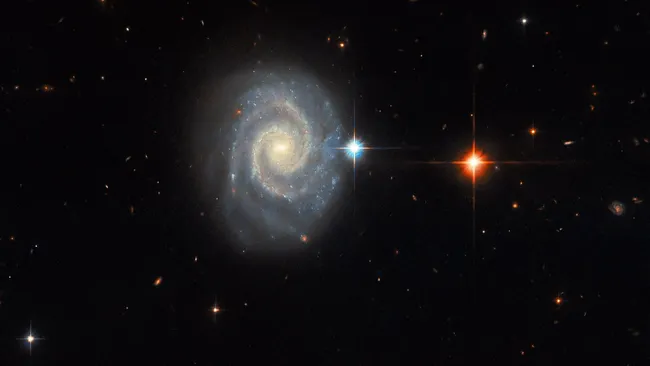Hubble Space Telescope Captures Mesmerizing New Image Featuring the ‘Forbidden’ Light of a Galaxy
The Hubble Space Telescope has captured the radiant “forbidden” light emanating from a distant spiral galaxy. Positioned approximately 275 million light-years away from Earth, the galaxy, named MCG-01-24-014, showcases distinct spiral arms and a vibrant, luminous core recognized as an active galactic nucleus (AGN).
Observed face-on, the galaxy presents a nearly perfect circular formation with well-defined arms. MCG-01-24-014 falls under the classification of a Type-2 Seyfert galaxy, belonging to one of the two major groups of active galaxies alongside quasars.
Seyfert galaxies exhibit a characteristic bright core, although they are comparatively less conspicuous than quasars. Quasars, with their exceptionally luminous AGNs, can surpass the entire brightness of the host galaxies in which they are situated, as explained in a statement by the European Space Agency (ESA).

Seyfert galaxies can be further differentiated based on the intensity of light emanating from their active cores. Depending on the wavelengths of light, or spectra, Seyfert galaxies fall into either Type-1 or Type-2 classifications. The latter category emits spectral lines associated with what are termed “forbidden” emissions, as these emissions are not expected to exist according to certain rules of quantum physics.
“To comprehend why the emitted light from a galaxy is labeled as forbidden, it is helpful to understand the underlying reasons for the existence of spectra,” explained officials from the European Space Agency (ESA) in the statement. “Spectra have distinct appearances because certain atoms and molecules reliably absorb and emit light at very specific wavelengths.
” Electrons, the minute particles orbiting the nuclei of atoms, either lose or gain specific amounts of energy, corresponding to particular light wavelengths being absorbed or emitted. However, certain spectral emission lines are considered “forbidden” because they are observed in space but do not manifest under typical conditions on Earth.
“Quantum physics is intricate, and certain assumptions used to model it are tailored to laboratory conditions on Earth,” noted officials from the European Space Agency (ESA) in the statement. “Within the confines of these rules, the emission is deemed ‘forbidden’—an event so improbable that it is typically dismissed.
However, in the vast expanse of space, amidst an intensely energetic galactic core, these assumptions no longer apply, allowing the ‘forbidden’ light an opportunity to illuminate and reach us.” Indeed, the luminous glow from MCG-01-24-014 captivates in the recent Hubble photograph, captured using the Advanced Camera for Surveys (ACS). The spiral galaxy takes center stage in the image, flanked by two prominent bright stars in the foreground—one blue and one red—directly positioned above the galaxy. Against the otherwise dark expanse of space, numerous distant galaxies are scattered. ESA unveiled the new Hubble image online on December 18.
This article is republished from Space.com under a Creative Commons license. Read the original article.
Do not forget to share your opinion with us to provide you with the best posts !



0 Comments